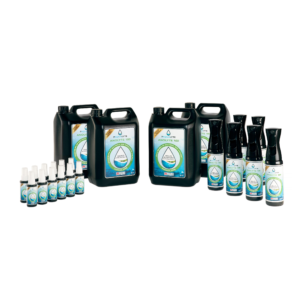PaquaLyte: A Sustainable and Effective Alternative to Bleach
'Nature's own powerful, non-toxic disinfectant.'

In 2023, many of us are trying to make positive changes to reduce our carbon footprint, and our cleaning practices should be no different. At Paqua, we know that our customers want to go greener, without compromising on quality. Our natural disinfectant PaquaLyte, is the solution to both your environmental and practical concerns. We are incredibly proud of the innovation behind this product. Not only is it incredibly effective in fighting bacteria, but it is produced without causing damage to the planet along the way. This product is an electrolysed water disinfectant, utilising the power of nature to eliminate 99.99% of known bacteria and viruses.
PaquaLyte is the ideal alternative to cleaning products that have a harmful effect on the environment, such as household bleach. The manufacturing process for bleach can be hugely detrimental to the health of our eco system. It’s manufacture and use contributes to pollution of the planet; it creates persistent organic pollutants when frequently released into bodies of water. According to the University of West Virginia, factories producing these products emit toxins into the air during the ventilation and exhaust processes, and their studies show that there is an ongoing danger of biomagnification. PaquaLyte’s manufacture and production doesn’t release toxins or pollute the planet. To the contrary, it is a biproduct of our PaquaVida water filtration system which is low energy and non-pollutive.
Disinfecting all non-porous surfaces, PaquaLyte is up to 200 times more effective than bleach and is PH neutral. It was imperative to us that we provided our customers with a product that yielded exceptional cleaning results that can be relied on. The Paqualyte disinfectant has been rigorously and extensively tested within a UKAS lab against bacteria, spores, virus, and fungal contamination and has proven its efficacy in all tested situations. The specific BS EN testing performed covers appropriate consideration for its application in medical, domestic, veterinary, food preparation, aerosolization via fogging (all for non-porous surfaces), and water environments.

PaquaLyte’s vital, active ingredient is Hypochlorous Acid (HOCI). This ingredient is produced naturally in our bodies by white blood cells. Described in the British Dental Journal as ‘Nature’s own powerful, non-toxic disinfectant’, HOCI is ‘an essential part of our immune system’ and ‘eliminates pathogens [while] being inherently harmless, unlike most other disinfectants, which are toxic.’
When compared to alternatives such as wet wipes, the contrast of quality is significant. In Cardiff University’s study ‘Pathogen transfer and high variability in pathogen removal by detergent wipes’, it was found that there was a frequent spread of super bugs. Professor Jean-Yves Maillard stated their ‘report on the effectiveness of the most used detergent wipes in hospitals […] found that in all too many cases they are not up to the job, with results showing huge variability’. According to The British Dental Journal, ‘most wipes dry out before the solution has had the necessary contact time. However, hypochlorous can be sprayed liberally on all surface types and pathogens are neutralised within seconds.’
By being non-toxic, biodegradable, and safe, PaquaLyte leaves it’s users reassured that they aren’t harming themselves or the environment. There is no need for gloves when using this product, again, reducing your carbon footprint by removing the need to purchase PPE. PaquaLyte is, in it’s own right, a powerful and effective disinfectant; we have combined the strength of nature and innovative engineering to produce an exceptional antibacterial cleaning agent. It’s versatility across sectors such as agriculture, domestic and commercial, demonstrates the potential this product has to make a positive impact on the cleaning industry.
To find out more, visit the PaquaLyte product page, or get in contact with us!
Sofaya Looker-ere
Works Cited:
- Beirne, P. (2021) How bleach damages the environment and our health, Public Goods. Available at: https://tinyurl.com/3537vn8k
- Ramm, L. et al. (2015) ‘Pathogen transfer and high variability in pathogen removal by detergent wipes’, American Journal of Infection Control, 43(7), pp. 724–728. doi:10.1016/j.ajic.2015.03.024.
- ‘Nature’s own powerful, non-toxic disinfectant’ (2018) British Dental Journal, 224(7), pp. 553–553. doi:10.1038/sj.bdj.2018.302.
- Lynch, A. (2015) Turns out, wet wipes might not be the easy-cleaning solution you thought, Metro. Available at: https://metro.co.uk/2015/06/09/wet-wipes-could-actually-be-spreading-bacteria-rather-than-killing-it-says-study-5237230/#:~:text=The%20Cardiff%20University%20study%20claimed%20that%20the%20detergent,on%20common%20infections%2C%20including%20MRSA%20and%20C.%20difficile.